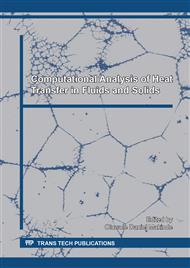[1]
N. T. Obot, Toward a better understanding of friction and heat/mass transfer in microchannel – A literatures review, Microscale Thermophysical Engineering, 6 (2002) 155-173.
DOI: 10.1080/10893950290053295
Google Scholar
[2]
T. M. Harms, M. J. Kazmierczak, F. M. Gerner, Developing convective heat transfer in deep rectangular microchannels, International Journal of Heat Fluid Flow, 20(1999) 149–157.
DOI: 10.1016/s0142-727x(98)10055-3
Google Scholar
[3]
G. L. Morini, M. Spiga, The role of the viscous dissipation in heated microchannels, ASME J. Heat Trans., 129 (2007) 308–318.
DOI: 10.1115/1.2430725
Google Scholar
[4]
G. Hetsroni, A. Mosyak, Z. Segal, Non uniform temperature distribution in electronic devices cooled by flow in parallel microchannels, IEEE Transactions on components and packaging technologies, 24(2001)17-23.
DOI: 10.1109/6144.910797
Google Scholar
[5]
G.L. Morini, Single-phase convective heat transfer in microchannels: a review of experimental results, International Journal of Thermal Science, 43 (2004) 631-651.
DOI: 10.1016/j.ijthermalsci.2004.01.003
Google Scholar
[6]
P.K. Namburu, D.P. Kulkarni, A. Dandekar, D.K. Das, Experimental investigation of viscosity and specific heat of silicon dioxide nanofluids, Micro NanoLett. 2 (3) (2007) 67-71.
DOI: 10.1049/mnl:20070037
Google Scholar
[7]
C.T. Nguyen, F. Desgranges, G. Roy, N. Galanis, T. Mare, S. Boucher, H. Angue Minsta, Temperature and particle-size dependent viscosity data for water based nanofluids – hystresis phenomenon. Int. J. Heat Fluid Flow 28 (2007) 1492–1506.
DOI: 10.1016/j.ijheatfluidflow.2007.02.004
Google Scholar
[8]
S. U. S Choi, Enhancing thermal conductivity of fluids with nanoparticles, In: Proc. 1995 ASME Int. Mech. Engng. Congress and Exposition, San Franciscos, USA, ASME, FED 231/MD 66 (1995) 99–105.
Google Scholar
[9]
J. Buongiorno, Convective transport in nanofluids, ASME J. Heat Transf. 128 (2006)240-250.
Google Scholar
[10]
O. D. Makinde, T. Iskander, F. Mabood, W.A. Khan, M. S. Tshehla, MHD Couette-Poiseuille flow of variable viscosity nanofluids in a rotating permeable channel with Hall effects, Journal of Molecular Liquids, 221 (2016) 778-787.
DOI: 10.1016/j.molliq.2016.06.037
Google Scholar
[11]
O.D. Makinde, A.S. Eegunjobi, MHD couple stress nanofluid flow in a permeable wall channel with entropy generation and nonlinear radiative heat, Journal of Thermal Science and Technology, 12(2) 17-00252 (2017)JTST0033(1-16).
DOI: 10.1299/jtst.2017jtst0033
Google Scholar
[12]
M.H. Mkwizu, O.D. Makinde, Entropy generation in a variable viscosity channel flow of nanofluids with convective cooling, Comptes Rendus Mécanique, 343 (2015) 38-56.
DOI: 10.1016/j.crme.2014.09.002
Google Scholar
[13]
A.T. Olatundun, O.D. Makinde, Analysis of Blasius flow of hybrid nanofluids over a convectively heated surface. Defect and Diffusion Forum, 377 (2017) 29-41, (2017).
DOI: 10.4028/www.scientific.net/ddf.377.29
Google Scholar
[14]
D. Cabaleiro, L. Colla, F. Agresti, L. Lugo, L. Fedele, Transport properties and heat transfer coefficients of ZnO/(ethylene glycol + water) nanofluids, Int. J. Heat Mass Transf. 89 (2015) 433–443.
DOI: 10.1016/j.ijheatmasstransfer.2015.05.067
Google Scholar
[15]
S.Z. Heris, M. Shokrgozar, S. Poorpharhang, M. Shanbedi, S.H. Noie, Experimental study of heat transfer of a car radiator with CuO/ethylene glycol-water as a coolant, J. Dispers. Sci. Technol. 35 (2014) 677–684.
DOI: 10.1080/01932691.2013.805301
Google Scholar
[16]
Z. Said, M.H. Sajid, M.A. Alim, R. Saidur, N.A. Rahim, Experimental investigation of the thermophysical properties of Al2O3-nanofluid and its effect on a flat plate solar collector, Int. Commun. Heat Mass 48 (2013) 99–107.
DOI: 10.1016/j.icheatmasstransfer.2013.09.005
Google Scholar
[17]
O.D. Makinde, Hermite-Padé approximation approach to steady flow of a liquid film with adiabatic free surface along an inclined heat plate, Physica A, Vol. 381, (2007) 1-7.
DOI: 10.1016/j.physa.2007.03.001
Google Scholar
[18]
C. Bender, and S. A. Orszag, Advanced mathematical methods for scientists and engineers, McGraw-Hill, (1978).
Google Scholar
[19]
A. J. Guttamann, Asymptotic analysis of power –series expansions, Phase Transitions and Critical Phenomena, C. Domb and J. K. Lebowitz, eds. Academic Press, New York, (1989)1-234.
Google Scholar
[20]
H. C. Brinkman, The viscosity of concentrated suspensions and solutions, J. Chem. Phys., 20(4), (1952) 571-571.
Google Scholar
[21]
ASHRAE, Handbook Fundamentals - SI Edition, American Society of Heating, Refrigerating and Air-Conditioning Engineers, Atlanta, USA, (2009).
Google Scholar


